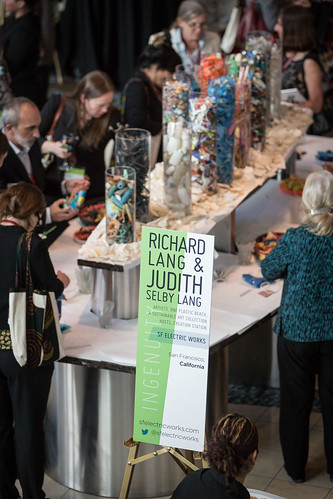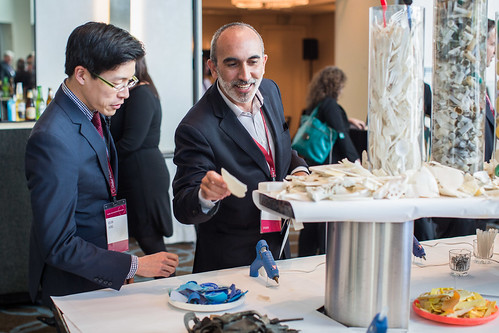Since 1999 Richard and Judith Lang have focused their attention on just 1000 yards of tide line where they have collected plastic washing ashore on Kehoe Beach in the Point Reyes National Seashore. Although the news about plastic pollution is dire, they bring the excitement of scouting for treasures and the pleasure of the creative life to an otherwise difficult topic.
Sunday, July 6, 2014
Where did all the plastic go?
Monday, June 9, 2014
World Oceans
Ranger John reminded that if we happened to find an artifact that looks like it might be of historical significance we should mark the spot and let the park archeologist investigate before removing it.
Sunday, June 1, 2014
This little piggy...
"Pig" comes from the Old English word for clay which was pygg. Money was kept in ceramic jars so it wasn't a big leap to piggy bank. The word "bank" comes from Italy where money lenders used benches or banks in a public square. When a banker went out of business his bench was smashed. He was broke. Breaking the bank extended to ceramic piggy banks. The oldest clay bank (15th C) in the form of a pig was found in Java—shattered but no money nearby.
The pigs of our Pyramid Scheme present the old story of a penny saved. What does it say about the state of our relationship with money when, in a single day of collecting plastic from a beach on the Gulf Coast, we found five plastic piggy banks washed ashore?
As new financial instruments flourish—from electronic trading, to credit cards, to Bit Coin and Ripple, to DIY person-to-person trading, the financial world is being "hacked" to illuminate new ways of looking at money. We present Pyramid Scheme as a new way of looking at an old story.
Sunday, April 27, 2014

Since the Global Philanthropy Forum conference, where we were enthralled by tales of programs to vanquish world poverty, environmental deprecations, ill health — we’ve been buoyed by the antitoxin of hope — a remedy for all of the bad news washing through the media.
We had some distant sense of what it takes to fund and manage philanthropic programs all over the planet but had few detail of what’s “under the hood.” We had no real measure of the scope and magnitude of the achievements. It was meeting the actual people who have dedicated their lives to making a better world for all that gave us the boost. We met academics who teach management skills, team building, fund raising. We met boots-on-the ground folks who have created the most innovative educational, agricultural initiatives. Building a Community of Donors and Social Investors Committed to International Causes is the perfect tag-line with this year’s theme: Global Goals, Citizen Solutions. And what a community it is!
The Forum is a big stage with major players: World Bank, MacArthur, Ford, Hilton, Hewlett, a real who’s who of heavy-hitters with billions and billions of dollars flowing. It’s a little daunting, since we, of limited resources, want to do our part in the biggest way possible. Wondering how to leverage our smallest scale into making a big impact.
We were asked to join in because we fit in as citizen solutions—we are just two citizens trying to make a difference from a tiny place, from 1000 yards of one beach, that we see as a big mirror reflecting the whole of planet earth. We joke that we are the world’s smallest NGO and not even all that organized.
Back home and into the everyday flow, after the GPF we started thinking about our other philanthropic efforts. Making a difference with what we know best—being in the Garden of Forking Paths. Living the creative life. How embarking on an artistic project can oft times lead to the unbidden.
Examples:
The Poetry Jukebox. A project born of late night insomnia, Richard memorizing poetry as a palliative to worry, birthed the PJB leading to performing in public in a Judith designed costume, leading to becoming an auction item raising over $11,000. for such non-profits as the Bolinas Museum, the San Francisco Center for the Book. Not much money as it goes but full of impact and downright fun.
WPA mural restoration. A WPA-era mural at the San Geronimo Valley Community Center after years of neglect was restored. At Electric Works, our printshop business, we created fine art prints showing what the mural would look like once restored, with the sale of the prints to fund the restoration. When nearly $7,000 of the required $18,000 was raised, the Lions Club, Fireman’s Fund and a local benefactor stepped in. Today the Mural stands as monument to the largesse of many. It was art that got fund-raising started.
Art for good. At Electric Works, our gallery business, we sell a well-known author’s drawings to raise funds for his scholarship program ScholarMatch to make college possible for under-resourced students.
We think of our small scale efforts as the Grameen Bank of Philanthropy, micro-philanthropy. How do people of limited means contribute? Yes, lots of opportunity to do volunteer work abounds, but how to use what artists know best, what all of us know best when we allow it—pay attention to the ineffable and listen to the voices of serendipity.
Simply said, the painter paints and the canvas itself gives feedback. Fully engaged with creative practice, one learns the lesson over and over — the intended outcome of making an artwork is only a vehicle for paying attention to an impending surprise. How to talk about this without diving into a more or less academic discussion of creativity—TED talks abound with plenty of this. What to do? We need an image to fill out our thinking.
Books from our personal library travel through the house, often piled up on a bedside table or on a bench next to the couch. The ones with quick reads and pictures end up on the back of the toilet tank, waiting for that moment… A book great for that “purpose” is from the Childcraft library, part of the World Book Encyclopedia. Volume 2 with its orange cover from 1954 is illustrated stories and poems. While holding the book on his lap, it falls open to Lydia Marie Child, best known for her Thanksgiving poem “Over the River and through the Woods”. The poem Richard is looking at is her Apple Seed John…
POOR Johnny was bended well nigh double
With years of toil, and care, and trouble;
But his large old heart still felt the need
Of doing for others some kindly deed.
“But what can I do?” old Johnny said:
“I who work so hard for daily bread?
It takes heaps of money to do much good;
I am far too poor to do as I would.”
Good Lord, the very magic we're talking about. The perfect poem in a children's book, discovered while sitting on the john, unbidden yet called forth. Is there a better image? Old John Chapman, Johnny Apple Seed, a real-life person, who wanted to do good but was little more than an itinerant farm laborer, saved his apple cores and set out to plant the new United States with apple trees. The ultimate and finally, mythical father of Micro-philanthropy found here in the magic of serendipity… a man who only wanted "doing for others some kindly deed" and further, looking into the poet Lydia Marie Child, we discover she was a famous abolitionist, a fighter for Indian rights, a transcendentalist and part of a resistance movement against the materialization of American life. As the industrial revolution began pouring manufactured goods into the daily lives of Americans, she promoted simplicity as a way of life. To live more simply was an act of grace. And in another totally appropriate serendipity, Andrew Mellen, our partner in the micro-philanthropy venture is our friend and organizational maven of simplicity whose motto is "More Love, Less Stuff" ®.
Global Goals, Citizen Solutions
Saturday, April 19, 2014
Fire And Ice
Some say in ice.
From what I’ve tasted of desire
I hold with those who favor fire.
But if it had to perish twice,
I think I know enough of hate
To say that for destruction ice
Is also great
And would suffice.
During our morning commute we enjoy what we call books-on-tape which is really Judith reading aloud to Richard. This week we were spell bound by a review of Gershwin's book They are Taking Over by Tim Flannery in the New York Review of Books .
In his review Flannery recounts horror after horror from Gershwin's book about the crisis in the oceans and probable causes for the frightening demise:
Thanks to Rietta Hohman blogger and Marine Science Instructor for the Farallones Marine Sanctuary Association for helping to spread the word about our project especially to the fish purveyors and restauranteurs who read the Pucci Food blog. Read her interview Judith and Richard Lang Create Beautiful and Thought-Provoking Plastic Art from Beach Trash

Sunday, April 6, 2014
Cinéma vérité
We trekked to Kehoe today with three intrepid Tam High Schoolers: Hannah, Bella, and Paloma, who were on assignment to create a cinéma vérité style three minute piece to discover a cinematic truth - and what better truth than to document plastic on the beach.






















